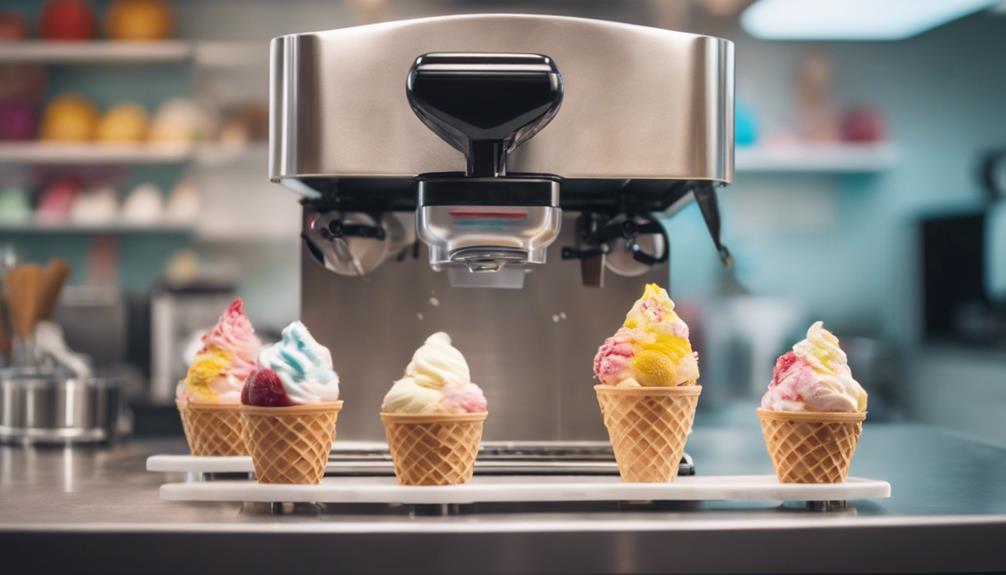To start a small ice cream business from home, you need to plan carefully and comply with local regulations. Begin by checking if your area allows home-based food production—many states require commercial kitchens or permits. Develop a solid business plan outlining your initial investment, which usually ranges from $20,000 to $50,000. Invest in essential equipment like an ice cream maker and commercial freezer. Use social media to engage customers and showcase unique flavors. Create a loyal customer base through promotions and community involvement. As you take these steps, you'll uncover more details to help your venture succeed.
Key Takeaways
- Research and comply with local regulations, including necessary licenses and food handling permits for home-based ice cream production.
- Create a solid business plan to outline startup costs, including equipment and ingredients, typically ranging from $20,000 to $50,000.
- Develop unique ice cream flavors and leverage social media for marketing and customer engagement, promoting seasonal or limited-time offerings.
- Maintain a clean and organized production space to meet health department standards, utilizing proper safety and sanitation practices.
- Consider shipping and delivery options, using insulated packaging to ensure ice cream remains frozen during transit for customer satisfaction.
Regulatory Compliance and Licensing

When starting a small ice cream business, understanding regulatory compliance and licensing is fundamental. Many states prohibit home-based ice cream manufacturing, so you'll likely need to use a commercial kitchen or an ice cream cart or truck. This is important because ice cream production falls under strict refrigeration regulations, making it ineligible for typical cottage food laws that only cover non-refrigerated items.
To operate legally, you must obtain the appropriate licenses and permits. This generally involves inspections and permits from local health and safety departments, which are essential for regulatory compliance. Additionally, securing food handling permits is critical to meet state regulations, guaranteeing the safe preparation and sale of your ice cream products.
Before diving in, take the time to research local regulations regarding licenses and permits. Requirements can vary greatly by location, and you may face regular health inspections.
Understanding these legal requirements will help you avoid costly fines and guarantee your ice cream business runs smoothly from day one. Stay informed and proactive about compliance to set a strong foundation for your entrepreneurial journey.
Business Planning and Start-Up Costs

To kick off your small ice cream business, you'll need a solid business plan that clearly outlines your concept and menu.
Your initial investment can range from $20,000 to $50,000, so breaking down these costs is essential for effective budgeting.
Understanding these essentials will set you up for success as you navigate the start-up phase.
Business Plan Essentials
Starting with a solid business plan is essential for launching your ice cream venture. Your plan should serve as a roadmap, guiding your operations and helping you secure funding. A thorough business plan includes several key components:
- Executive summary: A brief overview of your business concept.
- Management structure: Details on how your team will operate.
- Marketing analysis: Insights into your target market and competition.
When considering startup costs, be prepared to invest between $20,000 and $50,000 for a home-based operation, while brick-and-mortar locations can exceed $1 million.
Identifying ongoing expenses is vital; these can include employee wages, advertising, and permits/licenses.
A well-defined budget should factor in both hard costs (like equipment and furniture) and variable costs (like construction and permits).
This detailed financial planning helps you avoid cash flow issues during your initial months.
Lastly, utilizing financial projections, including sales forecasts and break-even analysis, will help assess your business's viability and attract potential investors or lenders.
Initial Investment Breakdown
Understanding the initial investment required for your ice cream business is vital to effective financial planning. Typically, you'll need to budget between $20,000 and $50,000, which covers fundamental equipment, ingredients, and necessary licenses.
One of the largest expenses will be your equipment. Ice cream makers, refrigerators, and freezers are critical for production and can take up a significant portion of your startup budget.
If you're converting a space into a commercial kitchen, be prepared for potential renovation costs that may add thousands to your initial investment, depending on local health department requirements.
Additionally, don't overlook the significance of obtaining a business license and any permits related to food handling and health regulations. These can range from a few hundred to several thousand dollars based on your location.
After launching, keep in mind the ongoing expenses, such as ingredients, employee wages (if you hire help), and advertising.
It's important to factor these costs into your budget to guarantee your business remains sustainable during the initial months of operation. Planning for these expenses will help you achieve success in your small ice cream venture.
Marketing Strategies and Customer Engagement

Effective marketing strategies and customer engagement are essential for the success of your small ice cream business. To attract and retain customers, you'll want to leverage social media platforms like Instagram and Facebook. Showcase your ice cream creations, engage your audience with promotions, and encourage user-generated content by asking customers to share their experiences.
Consider these tactics to enhance your marketing campaigns and boost customer service:
- Seasonal Promotions: Highlight limited-time flavors during holidays to create urgency and drive sales.
- Email Newsletters: Build an email list to share updates on new flavors, special promotions, and events, keeping customers engaged and encouraging repeat business.
- Loyalty Programs: Offer rewards for repeat customers, fostering retention and encouraging word-of-mouth referrals.
Additionally, collaborating with local businesses and participating in community events can greatly increase your brand visibility. This not only attracts new customers but also builds lasting relationships within your community.
Product Offerings and Legal Considerations
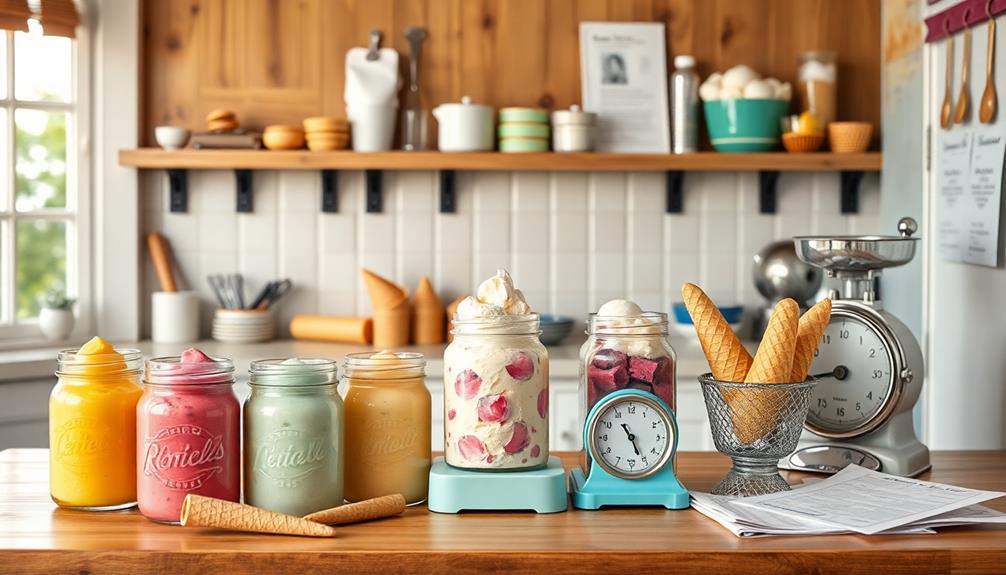
When launching your small ice cream business, it's vital to carefully plan your product offerings while steering through the necessary legal considerations. Many states prohibit home-based ice cream manufacturing due to health regulations, so you'll likely need to use a commercial kitchen or food truck. Understanding these requirements is fundamental to your success.
You must research your local health and safety department to obtain the necessary licenses and permits. This typically includes a food handling permit and possibly an ice cream shop license. Complying with these legal considerations will help you operate within the law and protect your business.
When formulating your ice cream products, remember to include detailed ingredient lists and allergy information. This transparency isn't just good practice; it's a stipulation for food safety regulations.
Don't forget to add expiration dates on your products, as this will further guarantee customer safety.
Lastly, stay updated on local regulations and regularly review your legal documents to maintain operational legitimacy. By prioritizing both your product offerings and legal obligations, you'll establish a strong foundation for your ice cream business.
Tools for Growth and Inventory Management
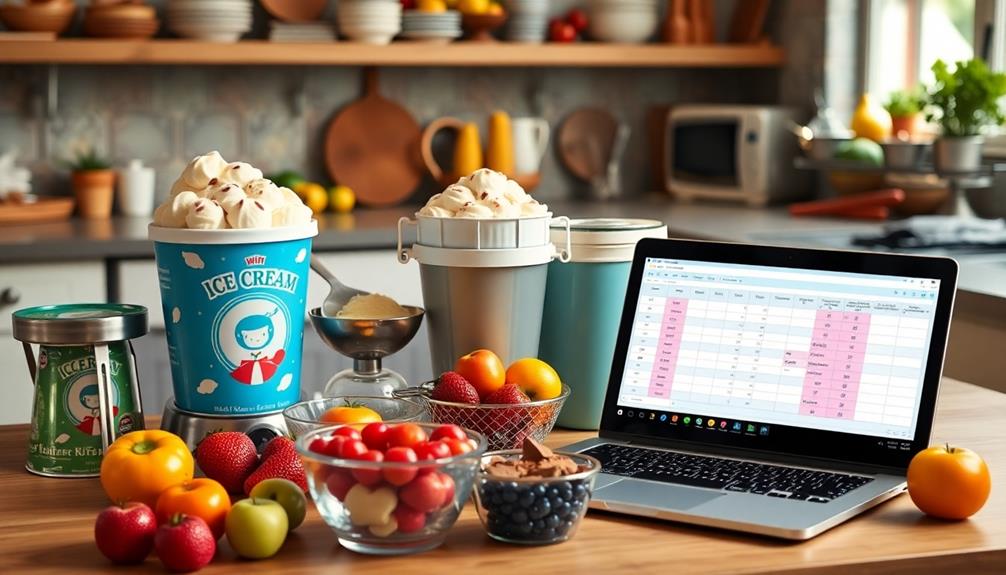
How can you guarantee your small ice cream business thrives in a competitive market? Utilizing the right tools for growth and inventory management is essential.
By implementing effective strategies, you can enhance operational efficiency and keep your customers coming back for more.
Consider these key tools:
- Inventory Tracking Software: Real-time updates prevent overselling and streamline stock management.
- Customer Records & Email Marketing: Build strong relationships through personalized communication and targeted promotions to boost customer retention.
- Marketing Automation Tools: Use data analytics to refine your campaigns, aligning them with customer preferences and seasonal trends.
Platforms like Castiron offer a fantastic way to build your online presence and manage orders effectively, especially with their 14-day free trial.
Automated inventory management reduces manual tracking efforts, letting you focus on creating delicious ice cream.
Creating Unique Ice Cream Flavors

To stand out in the crowded ice cream market, creating unique flavors is essential. Experiment with unique flavor combinations like lavender honey or chili chocolate to attract adventurous customers enthusiastic for something new. These distinctive options can set your offerings apart and get people talking.
Using locally-sourced ingredients, such as seasonal fruits or artisan chocolates, not only enhances your ice cream flavors but also supports local businesses. This approach appeals to community-conscious consumers who appreciate quality and sustainability.
Consider introducing limited-time flavors or seasonal specialties, as these novelty items can drive impulse purchases and encourage repeat visits. Regularly conducting taste tests and gathering customer feedback on flavor preferences will help you align your offerings with consumer desires and trends.
Don't shy away from flavor infusions, such as incorporating herbs or spices, to elevate traditional bases and create a truly unique taste experience.
Setting Up Your Home Kitchen

To set up your home kitchen for an ice cream business, you'll need the right equipment and tools to guarantee quality production.
Organizing your space efficiently is essential, as is maintaining safety and sanitation practices to comply with health regulations.
Let's explore what you'll need to get started on the right foot.
Necessary Equipment and Tools
Starting a small ice cream business from home requires careful investment in essential equipment. You'll need tools that not only enhance your production but also guarantee quality and compliance with health regulations.
Here are three key items you'll want to focus on:
- Ice cream maker: This is fundamental for achieving the right texture and consistency in your product.
- Commercial-grade freezer: Strict temperature control is necessary to keep your dairy ingredients fresh and safe.
- Dedicated dishwashing sink: Maintaining hygiene is critical, and having a separate sink will help you comply with health standards.
Additionally, invest in high-quality mixing bowls for effective blending, and consider a scale for precise ingredient measurements. Accurate ratios are important for achieving that perfect flavor and texture.
Don't forget to stock up on various containers for storage and packaging, such as pint-sized tubs for retail and insulated packaging for shipping orders. This will guarantee your ice cream stays fresh during transit.
With the right equipment, you'll be well on your way to creating delicious ice cream that customers will love!
Space and Organization Tips
Creating a dedicated space in your home kitchen for ice cream production is crucial for both quality and compliance with health regulations. Start by designating an area that meets local health standards, as home-based ice cream manufacturing is often restricted in many states.
Invest in essential equipment like a commercial-grade ice cream maker, refrigerators, and freezers to guarantee strict refrigeration for your ingredients.
Next, focus on organization. Allocate specific storage spaces for ingredients, toppings, and packaging materials. This will optimize your workflow and reduce production time.
Consider implementing a systematic inventory management system to help you track supplies, making sure you always have enough ingredients without overstocking or wasting precious resources.
Maintaining a clean and organized kitchen is crucial not just for efficiency but also to meet health department inspection requirements. Regularly clean and organize your kitchen tools and surfaces to create a safe environment for ice cream production.
Safety and Sanitation Practices
Establishing robust safety and sanitation practices in your home kitchen is essential for running a successful ice cream business. Compliance with local health regulations and cottage food laws is important, especially since selling refrigerated items like ice cream often requires a commercial kitchen.
To guarantee safety and sanitation in your kitchen, consider these key practices:
- Maintain cleanliness: Regularly clean all surfaces, utensils, and equipment to prevent contamination and foodborne illnesses.
- Proper refrigeration: Store all dairy ingredients at or below 40°F to inhibit bacterial growth and maintain freshness.
- Use color-coded tools: Implement color-coded cutting boards and utensils to avoid cross-contamination between allergens and non-allergen ingredients.
Additionally, obtaining a food handling permit and undergoing necessary inspections from your local health department is essential.
These measures not only guarantee compliance with health regulations but also build consumer trust in your products.
Shipping and Delivery Options
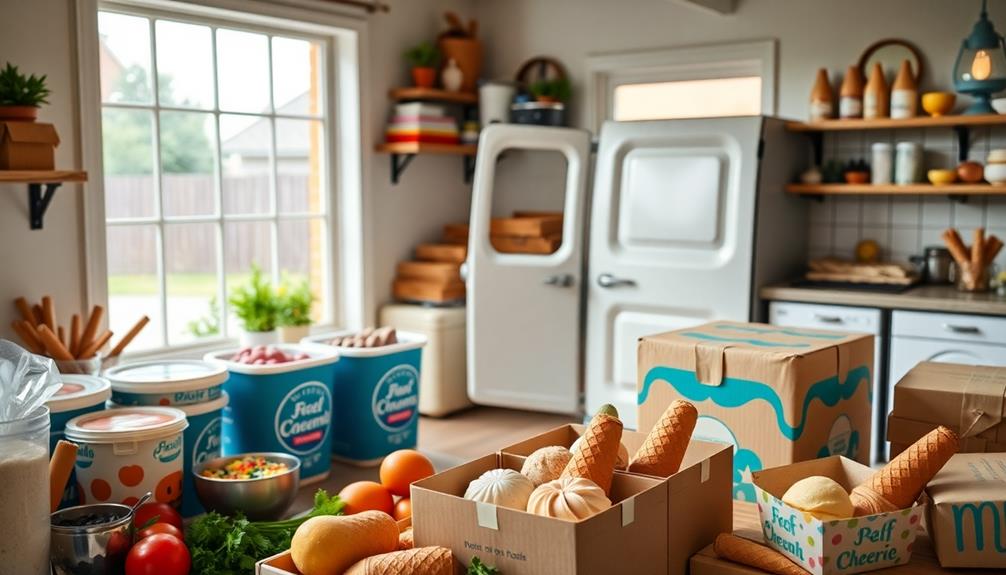
When it comes to shipping ice cream, you'll want to guarantee your products arrive at customers' doors in perfect condition. To achieve this, use insulated packaging and dry ice, ensuring your frozen treats stay frozen during transit.
Opt for overnight or two-day delivery options, as these are the most effective for maintaining quality.
It's essential to include ingredient lists, allergy information, and expiration dates on your shipped ice cream to comply with food safety regulations. This transparency not only boosts customer trust but also enhances customer satisfaction.
If you're considering a monthly subscription box model, this can be a great way to deliver curated flavors directly to your customers while fostering loyalty and creating a steady revenue stream.
Utilizing reliable courier services that specialize in perishable goods will improve your shipping efficiency. Timely delivery is key to ensuring your customers remain happy and keep coming back for more.
Implementing real-time inventory tracking and automated updates on shipping processes will help prevent overselling and streamline order fulfillment.
With the right shipping and delivery options, you'll set the stage for a successful ice cream business right from your home.
Building a Customer Loyalty Program

Creating a customer loyalty program is essential for boosting repeat business at your ice cream shop.
By implementing a points-based rewards structure, you can encourage customers to return more often while offering engaging promotions that keep them excited about their next visit.
This approach not only increases sales but also builds a loyal community around your brand.
Loyalty Rewards Structure
In the competitive world of small ice cream businesses, a well-structured loyalty rewards program can be your secret ingredient for fostering customer loyalty. By implementing a points-based system, you can encourage repeat visits, allowing customers to earn 1 point for every dollar spent. Once they reach specific thresholds, they can redeem these points for free items or discounts.
Consider these elements to enhance your loyalty program:
- Exclusive Rewards: Offer birthday discounts or members-only flavors, boosting customer retention by up to 20%.
- Tiered Structure: Create levels that reward higher spending, with basic perks at lower tiers and premium benefits like free toppings at higher tiers.
- Digital Tracking: Use an app or card system to simplify tracking purchases and rewards, enhancing engagement through notifications about promotions.
Regularly analyze purchase data to tailor your rewards, ensuring they align with customer preferences.
Personalized offers can greatly boost engagement, with studies showing increases of up to 50%.
Engagement Through Promotions
Promotions can be a game-changer in building engagement and loyalty among your ice cream shop customers. A well-structured loyalty program can boost repeat business by up to 30%. Consider offering rewards based on cumulative purchases, like a free scoop after ten visits. This kind of incentive encourages customers to keep coming back.
Seasonal promotions can also spark interest and excitement—think exclusive members-only flavors or discounts for loyalty program participants. These offerings not only enhance customer engagement but also foster a sense of community around your brand.
Don't underestimate the power of social media in this equation. Encourage customers to share their experiences or tag your business for loyalty points. This can greatly expand your reach and visibility, turning your loyal customers into brand advocates.
Lastly, regularly collecting feedback from your loyalty program members is essential. It helps you tailor your offerings to their preferences, leading to improved satisfaction and retention rates.
Keep your customers engaged, and watch your small ice cream business thrive!
Engaging With the Local Community
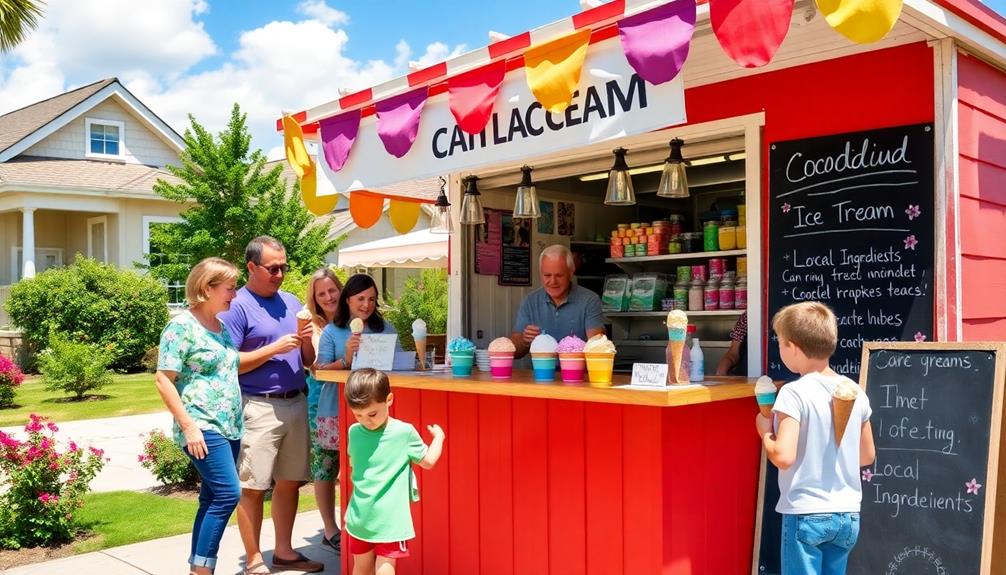
Engaging with the local community is essential for building a successful small ice cream business. By connecting with your neighbors, you can enhance brand visibility and foster loyalty. Remember, 70% of consumers prefer supporting local businesses, so make your presence known!
Here are three effective ways to engage:
- Participate in community events: Farmers markets and local festivals are great opportunities to showcase your ice cream and connect with potential customers.
- Collaborate with local businesses: Partnering with nearby organizations can expand your reach. Studies show that 72% of consumers are more likely to shop from brands that work with local partners.
- Utilize social media: Share stories, promotions, and customer interactions online. This not only strengthens community ties but also attracts new customers, as 54% of social media users engage with local businesses.
Additionally, consider implementing a loyalty program to reward repeat customers. A personalized experience can increase customer loyalty, with 66% of consumers more likely to stick with a brand that values their patronage.
Frequently Asked Questions
How Much Does It Cost to Start a Small Ice Cream Business?
Starting a small ice cream business can cost between $20,000 to $50,000. Initial expenses include equipment and renovations. Ongoing monthly costs may reach $10,000 or more, so having sufficient capital is essential for success.
Is a Homemade Ice Cream Business Profitable?
Yes, a homemade ice cream business can be profitable. By tapping into seasonal demand and offering unique flavors, you can considerably boost sales and enhance profit margins. Smart marketing strategies will help you attract loyal customers.
Is It Worth It to Make Ice Cream at Home?
Isn't it delightful to create your own ice cream? Making it at home's definitely worth it; you save money, customize flavors, and enjoy the satisfaction of crafting your delicious frozen treats while experimenting with ingredients.
What Is the Failure Rate of Ice Cream Shops?
The failure rate of ice cream shops is about 60% within three years. You'll face challenges like competition and seasonal demand. Effective planning and adaptability are essential if you want to succeed in this industry.
Conclusion
Starting a small ice cream business from home can be a delightful journey, like crafting your favorite flavor. With the right mix of planning, creativity, and community connection, you can scoop out a slice of success. Embrace the sweet moments of engaging with customers and watching your brand grow. Just remember, every great recipe takes time to perfect, but with passion and dedication, you'll be serving up smiles in no time. Enjoy the ride!

